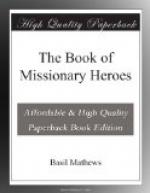The sunshine was very, very hot indeed—so hot that the bricks became hard and dry and strong. Day after day Shomolekae worked until he had made a big heap of bricks. With these he built a little house for Mr. Wookey to live in. But these sun-dried bricks soon spoil if they get wet, so he had to build a verandah to keep the rain from the walls.
When the house was built and Mr. Wookey was settled in it, they travelled still further up the river to learn what people were living there.
After a while it was decided that Shomolekae should go and live in a small village by the river, and there again begin his work of telling the men and women of Jesus Christ, and teaching the boys and girls to read.
In his satchel, which was made of odd bits of calico print of different patterns, Shomolekae had a hymn-book with music. The hymn-book was written in the language of the people—the Sechuana language—and Shomolekae taught them from the book to sing hymns. The music was the sol-fa notation.
This is one of the hymns:
1. “Yesu oa me oa nthata,
Leha ke le mo
dibin;
A re yalo mo kwalon,
A re yalo mo pedun.
E,
Yesu oa me,
E,
Yesu oa me,
E,
Yesu oa me,
Oa
me, mo loraton.
2. “Yesu oa me oa nthata,
O ntehetse molato;
O mpusitse timelon,
O ntlhapisa mo
pedun.
“E, Yesu oa me,” etc.
This is what these words mean in English. I expect you know them very well.
1. “Jesus loves me, this I
know,
For the Bible
tells me so;
Little ones to
Him belong,
They are weak,
but He is strong.
“Yes,
Jesus loves me,
Yes,
Jesus loves me,
Yes,
Jesus loves me—
The
Bible tells me so.
2. “Jesus loves me, He who
died
Heaven’s
gate to open wide;
He will wash away
my sin,
Let His little
child come in.
“Yes, Jesus loves me,” etc.
But, you see, the missionary had to alter the words sometimes so as to make the Sechuana lines come right for the music; and the second verse really means:
“My Jesus loves me;
He has paid my debt;
He has brought me back from
where I strayed;
He has washed my heart.
Yes, my Jesus,
Yes, my Jesus.
Yes, my Jesus.
Mine in love.”
They would learn the words off by heart because there was only the one hymn-book, and they would sing them together, Shomolekae’s voice leading.
They learned them so well that sometimes when the mothers were out hoeing in the fields, or the little boys were paddling in their canoes and fishing in the marshy waters, you would hear them singing the hymns that they learned in Shomolekae’s little school hut.
Then on Sunday they would have Sunday-school, and when that was over Shomolekae would gather the chocolate-faced men and women and boys and girls together—all who would come—and he would teach them to kneel down and pray to the one God, Who is our Father, and they would sing the hymns that they had learned, and then he would speak to them a simple little address, telling them of the Lord Jesus.




